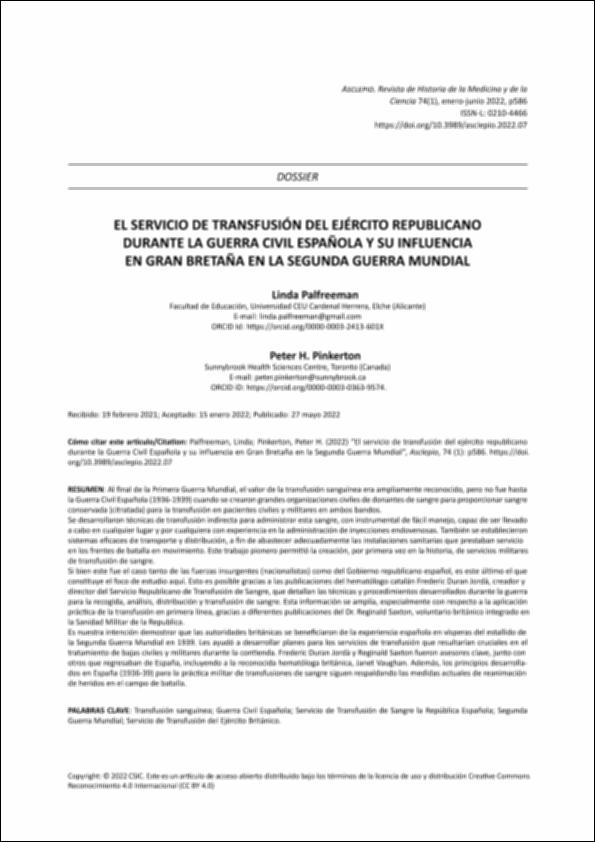Please use this identifier to cite or link to this item:
http://hdl.handle.net/10637/14329El servicio de transfusión del ejército republicano durante la Guerra Civil Española y su influencia en Gran Bretaña en la Segunda Guerra Mundial
| Title: | El servicio de transfusión del ejército republicano durante la Guerra Civil Española y su influencia en Gran Bretaña en la Segunda Guerra Mundial |
| Other Titles: | The Blood Transfusion Service of the Republican Army during the Spanish Civil War and its influece in Great Britain in World War II |
| Authors : | Palfreeman, Linda Pinkerton, Peter |
| Keywords: | Servicios de urgencias médicas - 1936-1939 - España.; Servicios de urgencias médicas - 1939-1945 - Gran Bretaña.; Blood - Transfusion.; Emergency medical services - 1939-1945 - Great Britain.; Emergency medical services - 1936-1939 - Spain.; Sangre - Transfusión.; Spain - History - Civil War, 1936-1939 -Medical care.; Great Britain - History - 1939-1945 - Medical care.; España - Historia - 1936-1939, Guerra Civil - Asistencia sanitaria.; Gran Bretaña - Historia - 1939-1945, Guerra - Asistencia sanitaria. |
| Publisher: | Consejo Superior de Investigaciones Científicas (CSIC). |
| Citation: | Palfreeman, L. & Pinkerton, P. H. (2022). El servicio de transfusión del ejército republicano durante la Guerra Civil Española y su influencia en Gran Bretaña en la Segunda Guerra Mundial. Asclepio, vol. 74, n. 1 (27 may.), art. p586. DOI: https://doi.org/10.3989/asclepio.2022.07 |
| Abstract: | Al final de la Primera Guerra Mundial, el valor de la transfusión sanguínea era ampliamente reconocido, pero no fue hasta
la Guerra Civil Española (1936-1939) cuando se crearon grandes organizaciones civiles de donantes de sangre para proporcionar sangre
conservada (citratada) para la transfusión en pacientes civiles y militares en ambos bandos.
Se desarrollaron técnicas de transfusión indirecta para administrar esta sangre, con instrumental de fácil manejo, capaz de ser llevado
a cabo en cualquier lugar y por cualquiera con experiencia en la administración de inyecciones endovenosas. También se establecieron
sistemas eficaces de transporte y distribución, a fin de abastecer adecuadamente las instalaciones sanitarias que prestaban servicio
en los frentes de batalla en movimiento. Este trabajo pionero permitió la creación, por primera vez en la historia, de servicios militares
de transfusión de sangre.
Si bien este fue el caso tanto de las fuerzas insurgentes (nacionalistas) como del Gobierno republicano español, es este último el que
constituye el foco de estudio aquí. Esto es posible gracias a las publicaciones del hematólogo catalán Frederic Duran Jordà, creador y
director del Servicio Republicano de Transfusión de Sangre, que detallan las técnicas y procedimientos desarrollados durante la guerra
para la recogida, análisis, distribución y transfusión de sangre. Esta información se amplía, especialmente con respecto a la aplicación
práctica de la transfusión en primera línea, gracias a diferentes publicaciones del Dr. Reginald Saxton, voluntario británico integrado en
la Sanidad Militar de la Republica.
Es nuestra intención demostrar que las autoridades británicas se beneficiaron de la experiencia española en vísperas del estallido de
la Segunda Guerra Mundial en 1939. Les ayudó a desarrollar planes para los servicios de transfusión que resultarían cruciales en el
tratamiento de bajas civiles y militares durante la contienda. Frederic Duran Jordà y Reginald Saxton fueron asesores clave, junto con
otros que regresaban de España, incluyendo a la reconocida hematóloga británica, Janet Vaughan. Además, los principios desarrollados
en España (1936-39) para la práctica militar de transfusiones de sangre siguen respaldando las medidas actuales de reanimación
de heridos en el campo de batalla. By the end of the First World War, the value of blood transfusion was widely recognized, but it was not until the Spanish Civil War (1936-1939) that large civilian blood donor organizations were created to provide preserved (citrated) blood for transfusion, for both civilian and military patients. Indirect transfusion techniques were developed to administer this blood, with easy-to-use instruments, capable of being carried out anywhere and by any medical personnel with experience in the administration of intravenous injections. Efficient transportation and distribution systems were also established in order to adequately supply the sanitary facilities that served the moving battle fronts. This pioneering work enabled the creation, for the first time in history, of military blood transfusion services. While this was the case for both the insurgent (Nationalist) forces and those of the Spanish Republican Government, it is the latter that forms the focus of this particular study. This is made possible by the publications of Catalan hematologist Frederic Duran Jordà, creator and director of the Republican Blood Transfusion Service, who details the techniques and procedures developed during the war for the collection, testing, distribution and transfusion of blood. Further insight – especially with regard to the practical application of front-line transfusion – can be gleaned from the various writings of Dr Reginald Saxton, British volunteer with the Republican Sanidad Militar. It is the intention, here, to demonstrate that the British authorities benefitted greatly from the Spanish experience in the development of plans for transfusion services that would prove crucial in treating civilian and military casualties during World War II (1939-1945). Frederic Duran Jordà, and Reginald Saxton were key advisers, together with others returning from Spain, including renowned British hematologist, Janet Vaughan. Moreover, the principles developed in Spain (1936-39) for delivery of military blood transfusion practice still support current measures in battlefield casualty resuscitation. |
| Description: | Este artículo se encuentra disponible en la siguiente URL: https://asclepio.revistas.csic.es/index.php/asclepio/article/view/1136/1955 |
| URI: | http://hdl.handle.net/10637/14329 |
| Rights : | http://creativecommons.org/licenses/by/4.0/deed.es |
| ISSN: | 0210-4466. 1988-3102 (Electrónico) |
| Language: | es |
| Issue Date: | 27-May-2022 |
| Center : | Universidad Cardenal Herrera-CEU |
| Appears in Collections: | Dpto. Humanidades |
Items in DSpace are protected by copyright, with all rights reserved, unless otherwise indicated.


